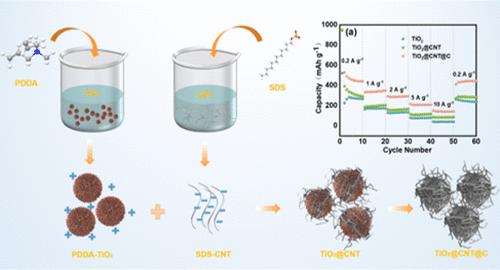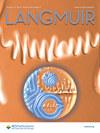Waxberry-like TiO2 with Synergistic Surface Modification of Pyrolytic Carbon Coating and Carbon Nanotubes as an Anode for Li-Ion Battery
IF 3.7
2区 化学
Q2 CHEMISTRY, MULTIDISCIPLINARY
引用次数: 0
Abstract
Titanium dioxide (TiO2) as an anode material for lithium-ion batteries (LIBs) has the advantages of tiny volume expansion, high operating voltage, and outstanding safety performance. However, due to the low conductivity of TiO2 and the slow diffusion rate of lithium ions (Li+), it is limited in the application of LIBs. Therefore, waxberry-like TiO2 comodified by pyrolytic carbon coating and carbon nanotubes was prepared in this work. The waxberry-like TiO2 with nanorods on its surface shortens the diffusion distance of Li+. Carbon nanotubes and waxberry-like TiO2 are tightly combined through electrostatic assembly and form a cross-linked conductive network to provide more electron transmission paths. A thin layer of pyrolytic carbon wraps carbon nanotubes and waxberry-like TiO2, which enhance the conductivity of the composites and ensure the structural integrity of the materials throughout the cycling process. The experimental data revealed that the discharge-specific capacity of TiO2@CNT@C is 170.5 mAh g–1 after 3000 cycles at a large current density of 5 A g–1, and the discharge-specific capacity is still 143 mAh g–1 at the superhigh rate of 10 A g–1, which provides excellent rate performance and cyclic stability. The efficient dual-carbon modification strategy could potentially be extended to other materials.

热解碳涂层和碳纳米管协同表面改性的蜡梅状 TiO2 作为锂离子电池的阳极
二氧化钛(TiO2)作为锂离子电池(LIB)的负极材料,具有体积膨胀小、工作电压高、安全性能优异等优点。然而,由于 TiO2 的导电率较低,且锂离子(Li+)的扩散速度较慢,因此其在锂离子电池中的应用受到了限制。因此,本研究制备了热解碳涂层和碳纳米管复合的蜡梅状 TiO2。表面带有纳米棒的蜡梅状 TiO2 缩短了 Li+ 的扩散距离。碳纳米管和蜡梅状 TiO2 通过静电组装紧密结合,形成交联导电网络,提供更多的电子传输路径。一层薄薄的热解碳包裹着碳纳米管和类蜡梅 TiO2,从而增强了复合材料的导电性,并确保了材料在整个循环过程中的结构完整性。实验数据显示,TiO2@CNT@C 在 5 A g-1 的大电流密度下循环 3000 次后,放电比容量为 170.5 mAh g-1,在 10 A g-1 的超高倍率下,放电比容量仍为 143 mAh g-1,具有优异的倍率性能和循环稳定性。这种高效的双碳改性策略有可能推广到其他材料上。
本文章由计算机程序翻译,如有差异,请以英文原文为准。
求助全文
约1分钟内获得全文
求助全文
来源期刊

Langmuir
化学-材料科学:综合
CiteScore
6.50
自引率
10.30%
发文量
1464
审稿时长
2.1 months
期刊介绍:
Langmuir is an interdisciplinary journal publishing articles in the following subject categories:
Colloids: surfactants and self-assembly, dispersions, emulsions, foams
Interfaces: adsorption, reactions, films, forces
Biological Interfaces: biocolloids, biomolecular and biomimetic materials
Materials: nano- and mesostructured materials, polymers, gels, liquid crystals
Electrochemistry: interfacial charge transfer, charge transport, electrocatalysis, electrokinetic phenomena, bioelectrochemistry
Devices and Applications: sensors, fluidics, patterning, catalysis, photonic crystals
However, when high-impact, original work is submitted that does not fit within the above categories, decisions to accept or decline such papers will be based on one criteria: What Would Irving Do?
Langmuir ranks #2 in citations out of 136 journals in the category of Physical Chemistry with 113,157 total citations. The journal received an Impact Factor of 4.384*.
This journal is also indexed in the categories of Materials Science (ranked #1) and Multidisciplinary Chemistry (ranked #5).
 求助内容:
求助内容: 应助结果提醒方式:
应助结果提醒方式:


